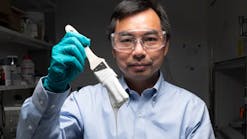It's not often that a Virginia Tech Hokie showers praise on rival Florida State University, but kudos to Asst. Prof. Lea Nienhaus and (former) post-doc Sarah Wieghold, and their entire lab team at FSU.
In “Understanding the effect of light and temperature on the optical properties and stability of mixed-ion halide perovskites” and “Investigating the effect of electric fields on lead halide perovskites by scanning tunneling microscopy," Drs. Nienhaus and Wieghold this year have explored ways to improve the performance of perovskites, which could lead to improved longevity and efficiency of solar photovoltaic (PV) cells.
For those who – like me – had never before heard of perovskites, there actually is a website dedicated to them called Perovskite-info. It defines them as "a class of materials that share a similar structure, which display a myriad of exciting properties like superconductivity, magnetoresistance and more.” (They are actually synthetic compounds that have a crystal structure identical to perovskite, a naturally-occurring calcium titanium oxide mineral.)
According to the U.S. Dept. of Energy’s Solar Energy Technologies Office (part of the Office of Energy Efficiency & Renewable Energy), perovskite solar cells have been around since 2006 and “have shown remarkable progress in recent years with rapid increases in conversion efficiency, from reports of about 3% in 2006, to over 25% in 2020.” Although this degree of efficiency improvement is such a relatively short time frame is remarkable, there are some daunting obstacles to overcome if this is to become a viable commercially-available technology.
Perhaps the most significant limitation is the material’s relative instability when compared to other PV technologies. Perovskites are “soft matter” and tend to degrade when exposed to moisture, extended periods of light, and high heat, Prof. Nienhaus’ research team found that adding a small amount of the cesium to perovskite film increased its thermal and photo stability. They also investigated the relationship between voltage and PV performance of perovskites. Obviously, increased stability is critical for development of commercial perovskites PV panels.
According to the Solar Energy Technologies Office, the environmental impact of the lead-based perovskite absorber presently being used is also an issue to be resolved, and efforts to identify low-toxicity absorbers are underway. As with any development of this type, a scalable and reproducible manufacturing process is critical to commercial success, and the solution to this challenge will likely determine the future of perovskites for PV.
##########
A regular contributor to HPAC Engineering and a member of its editorial advisory board since 2012, Larry Clark, LEED AP, O+M, is a principal at Sustainable Performance Solutions LLC, a south Florida-based engineering firm focusing on energy and sustainability. Email him at [email protected].










